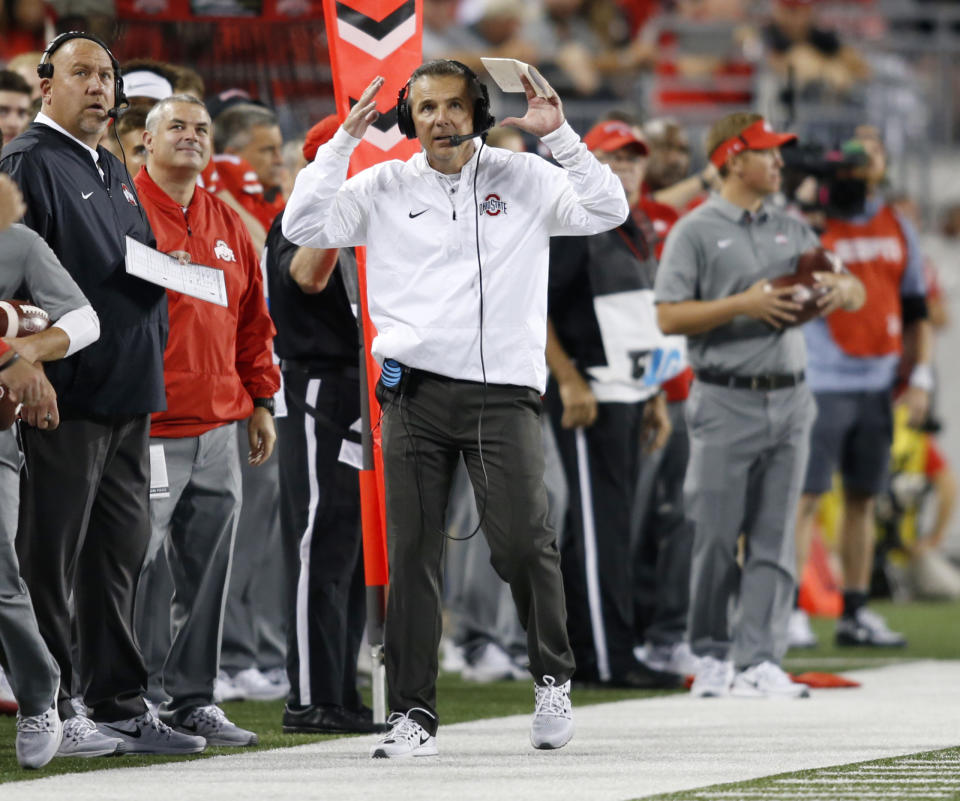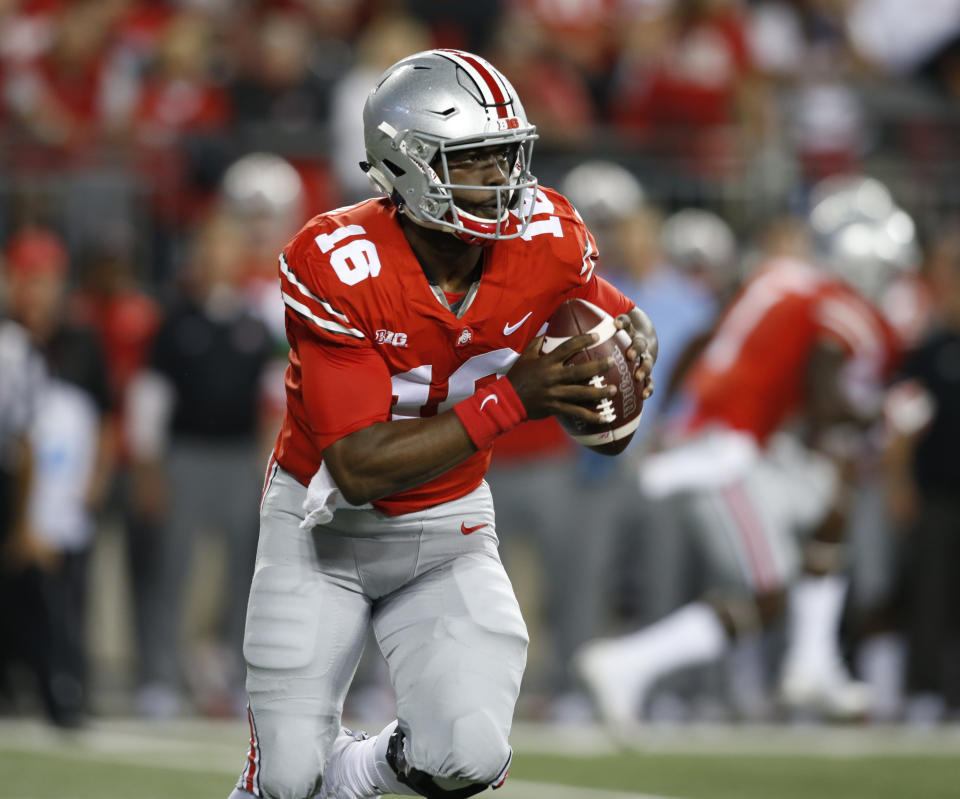Opposing coaches on what's wrong with Ohio State: 'It's the offense, not the QB'
COLUMBUS, Ohio – In the regulation periods of Ohio State’s past three games against marquee opponents – Michigan, Clemson and Oklahoma – the Buckeyes have what can be considered 34 full offensive possessions. Over that time, Ohio State can claim just one sustained touchdown drive – a seven-play, 44-yard drive against Oklahoma on Saturday night. The Buckeyes have punted 17 times, committed eight turnovers (counting downs) and kicked eight field goals (four makes and four misses).
With three of its past four games qualifying as offensive quagmires, the Buckeyes’ struggles have morphed from a blip to a trend. Urban Meyer acknowledged this after Ohio State’s 31-16 loss to Oklahoma on Saturday night. “We have to get the damn thing fixed,” Meyer said, “and we will.”
In Meyer’s 16 seasons as a head coach, this qualifies as one of the worst offensive slumps of his career. It would be unfair to call Ohio State’s offense completely broken, but it definitely needs fixing. The three-game sample size – Michigan, Clemson and Oklahoma – features an unusually high level of competition. The Buckeyes led the Big Ten in total offense (459 yards per game) in 2016 and ran up 596 yards in its opener at Indiana.
But Yahoo Sports spoke with multiple coaches who’ve studied the Buckeyes during this stretch of recent futility, and the main culprit behind Ohio State’s offensive struggles against top competition isn’t quarterback J.T. Barrett, new play caller Kevin Wilson or the undistinguished receiving corps.
“I think it’s probably more the offense than the quarterback,” said a veteran coach who studied the Buckeyes intensely this offseason. “I like J.T. and think he’s a capable athlete. The offense is hindering his ability to excel. It’s more of the offense than the player, in my opinion.”

Considering Meyer will go down in college football history as one of the top offensive minds of this and many generations, the Buckeyes’ struggles leave this season at an interesting crossroads.
Ohio State ranks No. 57 in the country in passing offense, which is actually an improvement from finishing No. 81 overall last season.
Meyer made a vow leading up to the College Football Playoff last year: “We’re going to become a good throwing team and spend some time on it.”
Barrett’s 19-for-35 showing Saturday, which included a critical interception early in the fourth quarter and no touchdowns, looked like more of the same big-game stagnation. From talking to people who’ve faced the Buckeyes recently or spent time preparing for them this offseason, they point to a lack of innovation and evolution as the biggest reason why Meyer’s offense is stuck in a rut against high-end competition. Once the paragon of offensive ingenuity, opponents see Ohio State as a step behind.
“There’s not a lot of creativity,” said the coach. “He’s doing a lot of the same things he did at Utah. We thought it would be different [with Kevin Wilson], but it hasn’t been.”
After Ohio State’s offense bottomed out at the end of last season, Meyer brought in new co-coordinators. Wilson came aboard soon after he got fired as Indiana’s head coach, and Chip Kelly protégée Ryan Day arrived from the NFL. While Ohio State flashed a few new wrinkles, the result against Oklahoma proved a near replica of what unfolded against Michigan and Clemson.
Wilson is one of this generation’s most respected play callers stretching back to his years as a coordinator at Oklahoma, but a two-game sample size shows limited philosophical influence. Surely, Meyer wasn’t going to throw him the keys and let him run everything he did at Oklahoma and Indiana – run/pass options, constant vertical routes and hyper tempo – with impunity. A team’s offensive identity can’t change that drastically. (One nuance a coach pointed out is that Wilson prefers to run his spread with a tight end, and that may be the weakest position on the Buckeyes roster right now).
But the same plays that have worked so well over the years for Meyer – especially quarterback runs – have become a crutch. And that’s become a vulnerability, especially because Ohio State’s inability to connect and unwillingness to throw deep balls have left the line of scrimmage stacked with defenders. Meyer admitted on Monday that Barrett ran the ball too much against Oklahoma. He’d like his tailbacks – dazzling freshman J.K. Dobbins and redshirt sophomore Mike Weber – to combine for between 25 and 30 touches. (Weber’s balky hamstring limited him in the opening two games). Barrett ran the ball (18 times) more than the tailbacks (16 carries) against Oklahoma. “That’s not enough,” Meyer said of the tailbacks.
The first two games have felt like Wilson trying to get comfortable calling Meyer’s offense, and that left the Buckeyes (1-1) stuck in neutral against Oklahoma. Meyer said Monday to expect a “continuing merging of ideas” of him, Wilson and Day. But so far, according to people who’ve studied the Buckeyes, Ohio State’s scheme hasn’t done service to their talent. “They have some damn athletes,” said a coach who studied the Buckeyes. “Their wide receivers can run and they’re all athletic. Their offensive line is good and there’s two good running backs. There’s no way that an offense like that should put 16 points on the board.”
Barrett has been a frequent target of fan criticism, and there’s a thirst in the local media for a quarterback controversy. Barrett is 27-5 as a starter and on pace to become the all-time wins leader in school history. Any notion of a quarterback controversy is more contrived clickbait than everyday reality. It would be stunning if Meyer pulled Barrett for either redshirt sophomore Joe Burrow or redshirt freshman Dwayne Haskins. The fact that no backup quarterback has emerged as a clear No. 2 – Haskins is considered the more talented player – pretty much ends any argument for change. Neither have the experience, knowledge or “game ready” nature that Barrett brings.
“Right now it’s not even a question,” Meyer said of potential change at the quarterback position.

But perhaps there’s a need for a schematic priority shift, as Wilson made his name early in his career in the run game at Northwestern and Oklahoma. Defenses have begun to exploit Barrett’s limitations as a pocket passer, as Oklahoma and Indiana practically dared Barrett to throw over the top. A coach who studied the Buckeyes this offseason charted Barrett’s throws in the Big 10, and more than 85 percent of his attempts were 15 yards or less. That profile allowed a team like Oklahoma to press up against Ohio State’s receivers, congest that space with zone coverage and dare the Buckeyes to beat them with a shot.
Ohio State took just four or five “shots” over the top of the Sooner defense, completing one – a 31-yarder to Austin Mack. Along with needing to attempt and complete more balls over the top of defenses to loosen them, the Buckeyes may be better served riding an offensive line whose five starters average 6-foot-6 and more than 310 pounds. The Buckeyes, other than one second-half possession, never attempted to impose their will on a Big 12 defense on Saturday. They fiddled around trying to establish Dobbins on the perimeter, not getting him in a rhythm between the tackles until the second half.
“They have more room to grow in the run game than they do in the pass game,” Big Ten Network analyst Gerry DiNardo told Yahoo Sports on Monday. “Ohio State’s wide receivers had trouble shaking coverage.”
An NFL scout familiar with the Buckeyes came away with this observation after Saturday night: “It’s like four of the six years Meyer has been there, they’ve had zero identity on offense.”
The last time Ohio State lost its home opener came against unranked Virginia Tech during Barrett’s redshirt freshman season in 2014. That Buckeyes team found an identity by riding Ezekiel Elliott and a gnashing offensive line all the way to the national title. There’s plenty of time for these Buckeyes to find themselves, as Meyer thrives when perfection is necessitated. Counting Ohio State out of the Big Ten and playoff race would be ignoring history.
Ohio State has a three-game stretch – Army, UNLV and at Rutgers – to find an identity and define its offense. Ohio State’s next marquee opponent is Penn State on Oct. 28, but there will be challenging games against Maryland and at Nebraska leading into that. After Meyer has overseen three duds in four games, moving forward to a new identity may mean an evolution from his successful past.
More from Yahoo Sports:
• Why the two teams that need Kaepernick won’t sign him
• Japanese baseball star to forgo millions to play in U.S.
• Failed drug test could actually be good news for UFC star
• Why it’s time to really worry about Adrian Peterson

